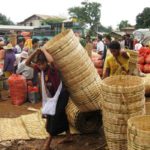Market day! We arrived at Inle Lake too late in the morning to make the five-day market in Nyaung Shwe, but this morning we had to get up very early (5am, as I recollect) to go to the five-day market in Heho.
The five-day market serves not just the residents of all the villages in and around Inle Lake, but also the tribal people living in the hills all around. Serving this large geographic area with this (relatively) small and diverse population, the market has developed a pattern of moving from place to place on a five-day rotating schedule. Hence the name.
On each fifth day, the market is held in more than one village or town at diverse locations around the lake. The market schedule is further complicated by the fact that no markets are held on the days of the full or new moon. (This at first seemed like a charming superstition, until we recollected that in some states in the US, stores have to stay closed on Sundays. And isn’t that just the same thing?)
Even so, many people have to come long distances. Retailers in these remote sites buy wholesale at the nearest market to them so that they can resell to the people in their area until the market comes around again five days later. People living closer just buy for themselves until the market comes around to some place close enough to go again. Thus, the market offers a wholesale as well as a retail section.
Dan says this is the best market of them all.
This could be true. Certainly it was fun to photograph, and certainly it’s been hard to winnow down our collective hundred-plus photos to a reasonable number to share. So today we’re just going to look at what it’s like to go to the market. Tomorrow, we’ll get there and look around.
Going to the market from our water-bound hotel is a two-stage process: by water to Nyaung Shwe (setting out shortly after sunrise), and from there by land to Heho.

At that early hour, the lake (and then the canal that connects to Nyaung Shwe) bore considerable traffic of market-goers, mostly vendors with goods to sell.



Once we reached the dock, we watched the boats being unloaded as we waited for our car.



Do you see the two men carrying the basket of tomatoes on a pole?
When the car arrived, we set out by land.

Well, will you look at that! Between people and goods, they’ve managed to fit quite a load onto that truck!

As you can imagine, they’re not going too fast. We pass them and reach Heho. Somehow, this reminds me of the idea of a town in the Wild West. The turnoff to the market is just ahead.




Whoa, here comes that truck again!

And there it goes. There is a place where all the trucks can park. This one is probably headed over there.

As for us pedestrians, there’s a whole informal little market just on the way to the regular market.

Tomorrow, we’ll visit the main market.





























































































































